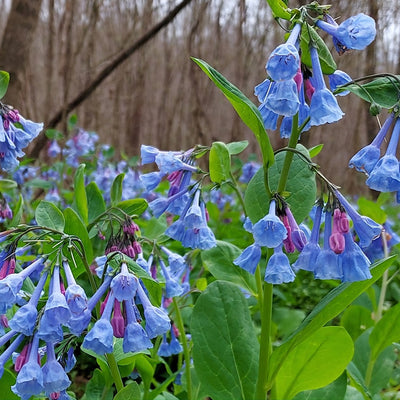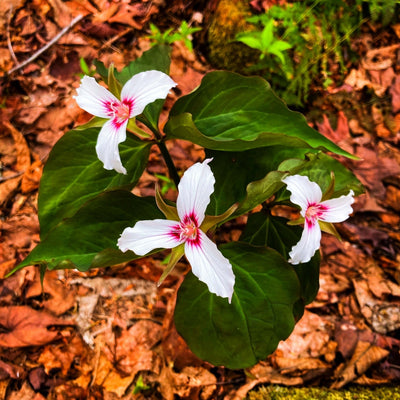Virginia Bluebell Guides
Virginia Bluebells, also called Mertensia virginica, are a great addition to your garden. They thrive in moist and rich soils, making them perfect for woodland gardens, as they bloom in early spring. These plants originated in North America. Let us understand how to plant and care for them.
Virginia Bluebells, ironically dubbed Bluebells of Scotland, are lovely blooms for your garden. Virginia Bluebells are found in wooded regions where they spread easily through self-seeding. Under trees and alongside riverbanks, bluebell plants are commonly* found in wel\\l drained and moist soils. Bluebells are 1 to 2 feet and feature large, bell shaped flowers. Virginia Bluebells are also beneficial because they serve as excellent nectar sources for bees and butterflies.
When to Plant Virginia Bluebells
You have two options. For best results, try planting in spring or fall. This is crucial in aiding in the establishment of the plant’s roots. Plants that are spring-sown get to settle and flower in the same season, making for an abundant harvest. Fall sowing is also advantageous in that roots are readily embedded in the soil and the plant is primed for growth before the winter sets in, resulting in early spring flowering.
Best Region to Plant Virginia Bluebells
Virginia Bluebells flourish and are abundant in heritage and historical sites. A bonus for these sites is the spur trees. These are especially useful for the cultivation of Virginia Bluebells. These trees, along with dapple sunlight, benefit the bluebells by providing soil that is well-draining and retains moisture. Bluebells thrive during these dry seasons, where soil is kept moist, and shrub shield watering is obtainable.
Bluebells thrive in mulch, making them very easy to care for. When the organic substitute is advantageous with the soil, moisture is not lost. Plants are also primed for growth during these dry spells, where soil is kept moist and shrub shield watering is obtainable.
How to Plant Virginia Bluebells
Virginia Bluebells must be buried 2 to 3 inches under the surface to allow the roots to grow. Plant roots must be positioned to accommodate the hole, and the hole must be large enough to accommodate the roots of the plants. Plants must be positioned 12 to 18 inches apart to ensure enough space for growth. Water the plants adequately while making sure the soil remains moist but not soggy.
Are Virginia Bluebells Invasive?
Virginia Bluebells* are non-invasive and, therefore, never disruptive to an ecosystem. The slow spreading bluebell plants* self recede, making them popular to gardeners who prefer low-maintenance. We can manage the spread of these plants, as they are slow in their movement through self-seeding.
Virginia Bluebells and Wildlife
Virginia Bluebells are beneficial to the ecosystem as they provide food for different wildlife species. The presence of bluebells will encourage a thriving garden ecosystem, therefore making Virginia Bluebells an excellent garden choice.
When Do Virginia Bluebells Bloom?
Virginia Bluebells usually bloom around late March to early April, which is around the time spring begins. Their vibrant blue blooms create an impressive blue splash in any garden. This seemingly brief bloom is one of the features that make them a must-have for the garden, as they signify the arrival of warmer weather.
Care and Maintenance of Virginia Bluebells
Considering they do bloom once planted, they are fairly easy to take care of. Below are some easy steps to ensure they thrive in the garden. Drought periods will require them to be watered, but keep in mind not to water too much as they do not like waterlogged soil. Feeding the plants with a balanced fertilizer in the early stages of spring until bloom time is encouraged to promote growth and blooming.
Virginia Bluebells require very little pruning, but any dead, dying, or yellowing leaves that disrupt the general appearance of the plant should be removed.
Are Virginia Bluebells Trouble-free to Cultivate?
As long as their requirements are met, Virginia Bluebells are trouble-free to cultivate. If planted in a suitable place with shade, rich soil, moisture, and sufficient cover, they will flourish. Maintaining their condition is simple, and they thrive with low effort, making them an excellent choice for gardeners who want stunning flowers without much hassle.
Do Virginia Bluebells Bloom Every Year?
These plants are perennial, meaning they bloom every year. They can live for a long time, providing blooms every spring reliably, and can live for more than a decade, just like most of their kind. After blooming, they go dormant and spring back to life with foliage in the following spring.
Do Virginia Bluebells Have Companion Plants?
Virginia Bluebells, in addition to their aesthetics, can also be combined with other plants that thrive in shade, enhancing the overall beauty of the garden. A few of these plants are listed below.
-
Trillium: A native woodland plant with white or purple blossoms.
-
Columbine: Presents red and yellow blossoms and flourishes under the same conditions.
-
Hostas, wonderful for textural and foliar accents in shaded areas of the garden.
Woodland Phlox, a strikingly different companion that bears pink or purple flowers, which blend beautifully with the Bluebells.
Conclusion
There is no denying that Virginia Bluebells are beautiful flowers which require little maintenance while still managing to provide an aesthetic view to the garden. These flowers are capable of blooming sky blue petals which are ideal for spots that are somewhat dim where many plants are likely to perish. Due to their strategic placement in the garden and the required bit of maintenance, these lovely blooms can be reaped year after year.
If you are planning to purchase Virginia Bluebells for your garden, visit TN Nursery today for the best quality bluebell plants that we offer, along with various other amazing species.
FAQs
What are the interesting facts about Virginia bluebells?
Virginia bluebells (Mertensia virginica) are native to North America and are known for their stunning blue flowers. They thrive in moist, rich soils and are an excellent addition to shaded areas. These plants bloom in early spring and attract pollinators like bees and butterflies.
Does Virginia bluebells spread?
Virginia bluebells are not invasive. They spread gradually through reseeding but do not take over an area. They prefer shaded spots with moist soil and grow in controlled clusters.
Are Virginia bluebells hard to grow?
No, Virginia bluebells are easy to grow if planted in moist, rich soil with good shade. They are low-maintenance and come back year after year.
Do Virginia bluebells come back every year?
Yes, Virginia bluebells are perennials, meaning they will come back year after year. They can live for a decade or more, providing beautiful blooms each spring.
Where is the best place to plant Virginia bluebells?
Plant Virginia bluebells in shady, moist areas with rich, well-draining soil. They thrive under trees or along riverbanks where the soil remains consistently moist.
What is so special about bluebells?
The unique color of the Virginia bluebells and the fact they grow in shady moist areas makes the bluebells unique. They attract pollinators and bloom earlier than most flowers during spring.



